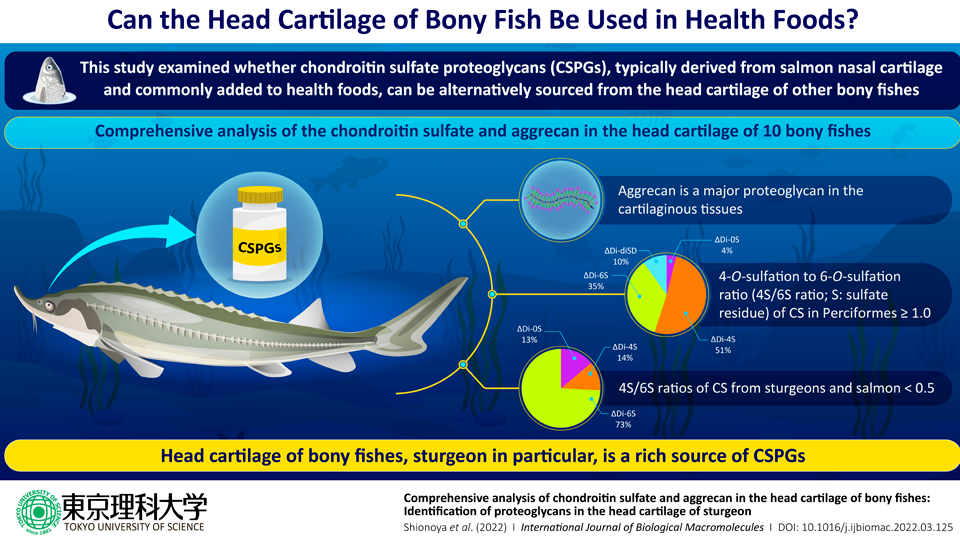Aggrecan, a significant component of proteoglycan (PG) in cartilaginous tissues with chondroitin sulfate (CS), is becoming more popular as a wellness food ingredient. Proteoglycans from salmon nasal cartilage have biological features like antiaging, angiogenesis suppression, and inflammatory response attenuation.
 New study analyzes the potential of bony fish head cartilage as an alternative source of proteoglycans and chondroitin sulfate for healthy food formulations. Image Credit: Tokyo University of Science
New study analyzes the potential of bony fish head cartilage as an alternative source of proteoglycans and chondroitin sulfate for healthy food formulations. Image Credit: Tokyo University of Science
Primarily salmon nasal cartilage has been used to make commercially accessible chondroitin sulfate proteoglycans (CSPGs). Although other edible bony fishes have head cartilage, nothing is known about the content of core proteins and their CS structures in the head cartilage.
A research team headed by Associate Professor Kyohei Higashi of Tokyo University of Science, as well as Dr Naoshi Dohmae and Dr Takehiro Suzuki of the RIKEN Center for Sustainable Resource Science now addresses this topic. The new study was published in the International Journal of Biology Macromolecules.
We found that composition of PGs and their CS structure in the skull of the Siberian sturgeon and Russian sturgeon were similar to that in the salmon nasal cartilage.”
Dr Kyohei Higashi, Associate Professor, Tokyo University of Science
Mr Atsuhi Nakamura of the Miyazaki Prefectural Fisheries Research Institute contributed the fish for the investigation. On March 23, 2022, this study was made accessible, and on May 31, 2022, it was released in Volume 208 of the journal.
CSPGs were found in abundance in the skull cartilage of all the fish studied. The structure of CS derived from Perciformes was similar to that of CS produced from terrestrial animal cartilage, according to a comprehensive examination of CS structure in PGs derived from 10 bony fishes. The structure of CS from sturgeon skulls, on the other side, was comparable to that of CS from salmon nasal cartilage.
In particular, aggrecan, a prominent CSPG in cartilaginous tissue, was found to be conserved in 10 bony fishes. In contrast, the aggrecan protein from the LOC117428125 and LOC117964296 genes discovered in the National Center for Biotechnology Information database was detected in abundance in sturgeons’ skulls. Moreover, the compositions of various PGs, collagens and matrix proteins in the skulls of sturgeons and salmon nasal cartilage were identical.
Head cartilage from bony fishes is an underutilized resource and is typically discarded after food processing. The PGs, especially from the sturgeon, are similar in CS structure to the salmon nasal cartilage, showing that the sturgeon has a lot of potential to be an alternative source of CSPGs for health food formulations.”
Dr Kyohei Higashi, Associate Professor, Tokyo University of Science
Bony fishes could become an excellent component of CS and PGs, according to the experts, if more research into the biological features of sturgeon PG is done.
Source:
Journal reference:
Shionoya, K., et al. (2022) Comprehensive analysis of chondroitin sulfate and aggrecan in the head cartilage of bony fishes: Identification of proteoglycans in the head cartilage of sturgeon. International Journal of Biological Macromolecules. doi.org/10.1016/j.ijbiomac.2022.03.125.